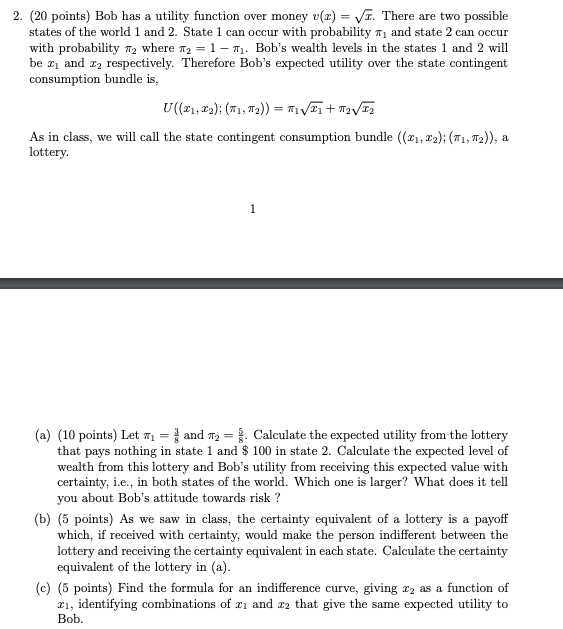Question
(20 points) Bob has a utility function over money v(x) = x. There are two possible states of the world 1 and 2. State 1
(20 points) Bob has a utility function over money v(x) = x. There are two possible states of the world 1 and 2. State 1 can occur with probability 1 and state 2 can occur with probability 2 where 2 = 1 1. Bob's wealth levels in the states 1 and 2 will be x1 and x2 respectively. Therefore Bob's expected utility over the state contingent consumption bundle is, U((x1, x2); (1, 2)) = 1 x1 + 2 x2 As in class, we will call the state contingent consumption bundle ((x1, x2); (1, 2)), a lottery.
1 (a) (10 points) Let 1 = 3 8 and 2 = 5 8 . Calculate the expected utility from the lottery that pays nothing in state 1 and $ 100 in state
2. Calculate the expected level of wealth from this lottery and Bob's utility from receiving this expected value with certainty, i.e., in both states of the world. Which one is larger? What does it tell you about Bob's attitude towards risk ?
(b) (5 points) As we saw in class, the certainty equivalent of a lottery is a payoff which, if received with certainty, would make the person indifferent between the lottery and receiving the certainty equivalent in each state. Calculate the certainty equivalent of the lottery in (a).
(c) (5 points) Find the formula for an indifference curve, giving x2 as a function of x1, identifying combinations of x1 and x2 that give the same expected utility to Bob.

Step by Step Solution
There are 3 Steps involved in it
Step: 1

Get Instant Access to Expert-Tailored Solutions
See step-by-step solutions with expert insights and AI powered tools for academic success
Step: 2

Step: 3

Ace Your Homework with AI
Get the answers you need in no time with our AI-driven, step-by-step assistance
Get Started


